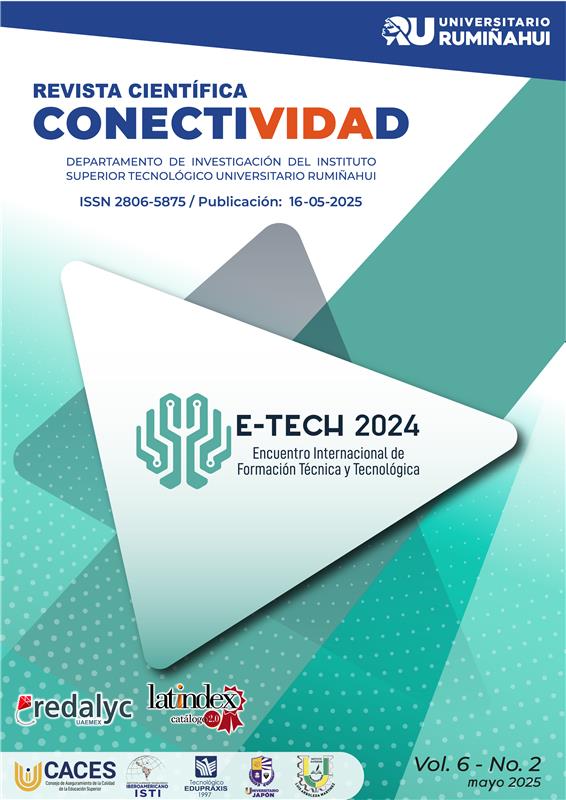Didáctica con inteligencia artificial para un aprendizaje activo en la educación media de Quito
DOI:
https://doi.org/10.37431/conectividad.v6i2.316Palabras clave:
Inteligencia artificial, Aprendizaje, Estrategias educativas, TecnologíaResumen
El presente trabajo investigativo tiene como finalidad indagar el nivel de uso tecnológico en la educación media de Quito. Se realizó un estudio de campo con cien docentes de diferentes instituciones públicas y privadas de educación media de la ciudad de Quito. La recolección de la información se realizó a través de la plataforma “Google Forms”. Entre los principales resultados se encuentra, el 75% indica que “nunca” o “muy poco” ha utilizado Inteligencia artificial generativa (AIG) y apenas el 10% “frecuentemente”. En cuanto a la nueva didáctica propone una mezcla de nuevas estrategias como: aula invertida, gamificación, Steam, Aprendizaje basado en problemas o proyectos (ABP), Aprendizaje basado en retos (ABR), las cuales estarán apoyadas con tecnologías que incorporen inteligencia artificial (IA) como: Chat GPT, Tome.app, Educaplay, GitMind entre otros. Finalmente concluye que la educación moderna debe estar apoyada por el uso de la IAG y que los docentes requieren constante capacitación para efectivizar el tiempo de enseñanza aprendizaje.
Citas
Buenrostro, E. (2022). Propuesta de adopción de tecnologías asociadas a la industria 4.0 en las pymes mexicanas. Entreciencias: diálogos en la sociedad del conocimiento, 42-54.
Burgos, J; et. al. (2010). Tecnología educativa y redes de aprendizaje. México: Trillas.
Camacho, M. U., Tambasco, P., Martinéz, S., & García Correa, M. (2023). El impacto de la Inteligencia Artificial en la educación. Riesgos y potencialidades de la IA en el aula. Revista interuniversitaria de investigación en tecnología educativa, 41-57. Obtenido de https://revistas.um.es/riite/article/view/584501 DOI: https://doi.org/10.6018/riite.584501
Edutrends, T. d. (17 de Febrero de 2016). Observatorio de innovación educativa. Obtenido de Aprendizaje basado en retos: https://observatorio.tec.mx/edutrendsabr
Fajardo Pascagaza, E., & Gil Bohórquez, B. (2019). El aprendizaje basado en proyectos y su relación con el desarrollo de competencias asociadas al trabajo colaborativo. Revista Amauta, 103. https://doi.org/10.15648/am.33.2019.8 DOI: https://doi.org/10.15648/am.33.2019.8
Garrel, A. (2019). La industria 4.0 en la sociedad digital. Barcelona: Marge.
González, A., Portillo , J., & Zangara, M. (2024). La Inteligencia Artificial Generativa en la Enseñanza Media. Propuesta de formación de docentes. Revista Iberoamericana de Tecnología en Educación y Educación en Tecnología, 78-88. https://doi.org/10.24215/18509959.37.e7 DOI: https://doi.org/10.24215/18509959.37.e7
Hernandez. (2018). Metodología de la Investigación. México: McGraw-Hill. DOI: https://doi.org/10.17993/CcyLl.2018.15
Kaplan, J. (2017). Inteligencia artificial. Lo que todo el mundo debe saber. Madrid: Comera.
Lemaitre, M. (2018). La educación superior como parte del sistema educativo en América Latina y el Caribe. Caracas: IESALC, Unesco. DOI: https://doi.org/10.29019/book.127055
López, M. (2013). Aprendizaje, competencias y Tic. México: Pearson, Educación.
Ramirez,M & Valenzuela, J. (2019). Innovación educativa. Tendencias globales de investigación e implicaciones prácticas. Barcelona: Octaedro.
Soto Ramírez, E. (2012). Un acercamiento a la didáctica general como ciencia y su significación en el buen desenvolvimiento de la clase. Revista Científico Pedagógica, 2.
Zugaste, et. al. (2022). Transformación digital en la relación entre industria y colectivo sanitario. Nutrición hospitalaria. , 18-30.
Ramírez Osorio, L. S. y López Gil, K. S. (2018) Orientar la escritura a través del currículo en la universidad. Sello Editorial Javeriano.
Jackson, L. M. (2019). The psychology of prejudice From attitudes to social action (2nd ed.). American Psychological Association.
https://doi.org/10.1037/0000168-000 DOI: https://doi.org/10.1037/0000168-000
Fernández Poncela, A. M. (2019). Patrimonio desde las percepciones, emociones, miradas y discursos sociales. Apuntes, 32 (2), 5 19.
https://doi.org/10.11144/Javeriana.apc32-2.ppem DOI: https://doi.org/10.11144/Javeriana.apc32-2.ppem
(Camacho, Tambasco, Martinéz, & García Correa, 2023).
Publicado
Cómo citar
Número
Sección
Licencia
Derechos de autor 2025 Instituto Superior Tecnológico Universitario Rumiñahui

Esta obra está bajo una licencia internacional Creative Commons Atribución-NoComercial 4.0.
Los originales publicados en la edición electrónica bajo derechos de primera publicación de la revista son del Instituto Superior Tecnológico Universitario Rumiñahui, por ello, es necesario citar la procedencia en cualquier reproducción parcial o total. Todos los contenidos de la revista electrónica se distribuyen bajo una licencia de Creative Commons Reconocimiento-NoComercial-4.0 Internacional.







2.png)






